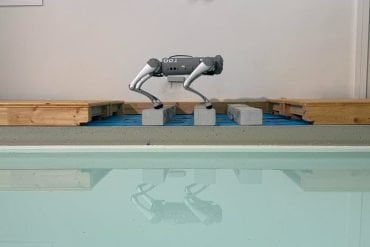Summary: A new study could change our understanding of hearing loss prevention and treatment. Researchers found that the ‘hair cells’ in our inner ear, crucial for hearing and balance, can repair themselves after suffering from damage.
Contrary to the common belief that these cells, once destroyed, are irrevocably lost, this research demonstrates their resilience and self-repair ability under stress. This novel insight could help design more effective strategies for preventing and treating hearing loss.
Key Facts:
- The study, led by researcher Jung-Bum Shin, PhD, revealed that auditory hair cells can self-repair from damage caused by loud noises or other forms of stress, challenging previously held beliefs about their permanency.
- The hair cells repair themselves by deploying a protein named XIRP2. XIRP2 can sense damage to the hair-like structures, known as stereocilia, and repairs them by filling in new actin.
- The National Institutes of Health has awarded over $2.3 million to fund further research into this self-repair mechanism, which holds potential for future treatment strategies for hearing loss and related conditions.
Source: University of Virginia
University of Virginia School of Medicine researchers have discovered how the cells that let us hear can repair themselves after being damaged.
That important insight could benefit efforts to develop new and better ways to treat and prevent hearing loss.

“Hair cells” found in the inner ear, are important both for our ability to hear and our sense of balance. They are known as hair cells because the cells are covered in hair-like structures that serve as mechanical antennas for sound detection.
“When auditory hair cells are killed, as we learn in school, they are gone for good. But the new UVA Health research shows these delicate cells have the ability to repair themselves from damage caused by loud noises or other forms of stress.
“For many years, auditory research has placed considerable emphasis on the regeneration of sensory hair cells. Although these efforts continue, it is equally important to enhance our comprehension of the intrinsic mechanisms that govern the repair and maintenance of these cells.
“By gaining a deeper understanding of these inherent repair processes, we can uncover strategies to fortify them effectively. One such approach in the future might involve the utilization of drugs that stimulate repair programs,” said researcher Jung-Bum Shin, PhD, of UVA’s Department of Neuroscience.
“In essence, when replacement of hair cells proves challenging, the focus shifts towards repairing them instead. This dual strategy of regeneration and repair holds strong potential in advancing treatments for hearing loss and associated conditions.”
Hearing Repair
Hair cells are naturally fragile – they must be delicate so they can sense sound, but they also must withstand the continuous mechanical stress inherent in their jobs.
Prolonged exposure to loud noise harms hair cells in a variety of ways, and one of those is by damaging the cores of the “hairs” themselves. These hair-like structures are known as stereocilia, and Shin’s new research shows a process they use to repair themselves.
The hair cells do this by deploying a protein called XIRP2, which has the ability to sense damage to the cores, which are made of a substance called actin. Shin and his team found that XIRP2 first senses damage, then migrates to the damage site and repairs the cores by filling in new actin.
“We are especially excited to have identified a novel mechanism by which XIRP2 can sense damage-associated distortions of the actin backbone,” Shin said.
“This is of relevance not only for hair cell research, but the broader cell biology discipline.”
The pioneering work has netted Shin and his colleagues more than $2.3 million from the National Institutes of Health, grant R01DC021176, to fund additional research into how the cores are repaired. By understanding this, scientists will be better positioned to develop new ways to battle hearing loss – even the kind that comes from aging, the researchers say.
“Age-related hearing loss affects at least a third of all older adults,” Shin said.
“Understanding and harnessing internal mechanisms by which hair cells counteract wear and tear will be crucial in identifying ways to prevent age-related hearing loss. Furthermore, this knowledge holds potential implications for associated conditions such as Alzheimer’s disease and other dementia conditions.”
Findings Published
The researchers have published their findings in the scientific journal eLife. The article is open access, meaning it is free to read.
The research team consisted of Elizabeth L. Wagner, Jun-Sub Im, Stefano Sala, Maura I. Nakahata, Terence E. Imbery, Sihan Li, Daniel Chen, Katherine Nimchuk, Yael Noy, David W. Archer, Wenhao Xu, George Hashisaki, Karen B. Avraham, Patrick W. Oakes and Shin. The researchers have no financial interest in the work.
Funding: The research was supported by the National Institutes of Health’s National Institute on Deafness and Other Communication Disorders, grants R01DC014254, R56DC017724, R01DC018842, R01DC011835 and 1F31DC017370-01. Additional support was provided by the Owens Family Foundation, the Virginia Lions Hearing Foundation, and a National Science Foundation CAREER Award.
About this auditory neuroscience research news
Author: Josh Barney
Source: University of Virginia
Contact: Josh Barney – University of Virginia
Image: The image is credited to Neuroscience News
Original Research: Open access.
“Repair of noise-induced damage to stereocilia F-actin cores is facilitated by XIRP2 and its novel mechanosensor domain” by Jung-Bum Shin et al. eLife
Abstract
Repair of noise-induced damage to stereocilia F-actin cores is facilitated by XIRP2 and its novel mechanosensor domain
Prolonged exposure to loud noise has been shown to affect inner ear sensory hair cells in a variety of deleterious manners, including damaging the stereocilia core.
The damaged sites can be visualized as ‘gaps’ in phalloidin staining of F-actin, and the enrichment of monomeric actin at these sites, along with an actin nucleator and crosslinker, suggests that localized remodeling occurs to repair the broken filaments.
Herein, we show that gaps in mouse auditory hair cells are largely repaired within 1 week of traumatic noise exposure through the incorporation of newly synthesized actin. We provide evidence that Xin actin binding repeat containing 2 (XIRP2) is required for the repair process and facilitates the enrichment of monomeric γ-actin at gaps.
Recruitment of XIRP2 to stereocilia gaps and stress fiber strain sites in fibroblasts is force-dependent, mediated by a novel mechanosensor domain located in the C-terminus of XIRP2.
Our study describes a novel process by which hair cells can recover from sublethal hair bundle damage and which may contribute to recovery from temporary hearing threshold shifts and the prevention of age-related hearing loss.







